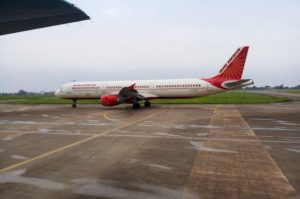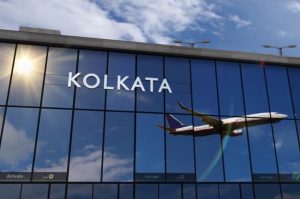Kolkata Airport International Passenger Traffic: After a brief and sudden slump in international passenger movement triggered by geopolitical tensions in the Gulf region, Netaji Subhas Chandra Bose International Airport (NSCBIA) in Kolkata has reported a return to normal levels of international travel. The airport, which had seen a dip in flyers owing to airspace closures in Qatar, the UAE, Bahrain, and Kuwait, is once again buzzing with outbound and inbound travelers.
Airport officials, aviation experts, and industry insiders confirm that the airport’s international footfall has normalized after the June 23–26 disruption, underscoring both the resilience of air travel in the post-pandemic era and Kolkata’s strategic dependence on Gulf transit hubs.

Context: West Asia Conflict and Its Fallout on Indian Aviation
The disruption was a result of rising regional hostilities after a missile strike in Qatar, which prompted emergency airspace shutdowns by several Gulf nations. These countries—home to major international aviation hubs like Doha (Hamad International Airport), Dubai International, Abu Dhabi International, and Kuwait International Airport—are central to Kolkata’s international connectivity.
Most flights from Kolkata to Europe, North America, and even parts of Africa are routed through these hubs. The sudden closure of these routes affected Kolkata disproportionately, despite the airport itself not being physically at risk.


Dependence on Gulf Hubs
Kolkata currently does not have direct flights to Europe or North America. Thus, nearly 80% of long-haul international travelers depend on transit flights via Gulf-based carriers like:
- Qatar Airways (via Doha)
- Emirates (via Dubai)
- Etihad (via Abu Dhabi)
- FlyDubai
- Kuwait Airways
These airlines operate some of the busiest international routes from NSCBIA. Any disruption in these corridors ripples immediately through Kolkata’s outbound air traffic.
For more on global aviation disruptions and crisis routing:
International Civil Aviation Organization – Crisis Response
The Dip: Numbers That Mattered
In the immediate aftermath of the June 23 airspace closures:
- International flight numbers fell from 42–45 daily to 34–36.
- Passenger footfall dropped from ~6,600 per day to below 5,000.
- Travel agents reported 25–30% cancellations or rescheduling.
- Many flyers postponed trips to Europe, Canada, and the US due to transit route instability.
Business travelers were particularly affected, with meetings delayed or shifted to virtual platforms.
The Rebound: Rapid Recovery After Reopening
By June 28, following partial reopening of Gulf airspaces and a halt in conflict escalation, flight schedules resumed and previously suspended flights were restored. According to data from the Airport Authority of India (AAI):
- By June 29, international passenger numbers had bounced back to above 6,500 per day.
- Gulf-based carriers returned to their regular slots.
- Airlines issued advisories and waived change fees, encouraging travelers to resume postponed journeys.
Airport Director Pravat Ranjan Beuria confirmed that passenger throughput had normalized completely, and queues at immigration and check-in counters had returned to expected volumes.
Airports Authority of India – Kolkata Traffic Statistics


Industry Reaction: Lessons from the Crisis
While the incident was brief, it left an impression on Kolkata’s tightly linked air travel sector:
Tour Operators
Travel agencies were the first to feel the tremors. Clients with tours to Europe and the Americas were forced to delay or cancel. Tour operators also faced issues with connecting flights, especially for student visas, business expos, and medical travelers.
“Every time there’s a geopolitical shake-up, Kolkata suffers disproportionately because of our lack of direct long-haul flights,” said a senior tour operator in Salt Lake. “This isn’t just an airport issue—it’s about connectivity planning.”
Airlines
Carriers like Qatar Airways and Emirates, who carry a large volume of Kolkata’s outbound long-haul passengers, responded swiftly with:
- Alternate flight routings
- Temporary code-shares
- Passenger advisories through SMS and app notifications
Despite the losses over three days, airlines restored full operations within a week.
Hospitality Sector
Hotels near the airport and in central Kolkata saw temporary booking drops by 10–15%. International travelers often book transit accommodation. With flights canceled or delayed, short-stay bookings dipped.
By July 1, bookings had rebounded, particularly with the start of Europe’s summer travel season, when inbound tourism spikes.
Broader Implications for Kolkata’s Aviation Ecosystem
This event reignites the debate on Kolkata’s international aviation limitations:
Lack of Direct Flights
Unlike Delhi, Mumbai, or even Bengaluru, Kolkata lacks direct connections to:
- Europe (London, Paris, Frankfurt)
- US and Canada (New York, Toronto)
- Far East (Tokyo, Sydney)
This makes the airport vulnerable to disruptions in intermediary Gulf routes.
Proposed Solutions
- Expansion of Air India’s international operations from Kolkata, leveraging the airline’s long-haul fleet
- Incentives to attract foreign carriers to launch direct Europe-Kolkata routes
- Revival of bilateral agreements with European nations for landing slots
Ministry of Civil Aviation – Route Dispersal Guidelines
Kolkata Airport International Passenger Traffic: Infrastructure Resilience at NSCBIA
Despite the crisis, NSCBIA’s operations remained smooth and professional. This was possible due to:
- Digital flight tracking systems that updated delays and reroutes in real-time
- A fully operational emergency response team
- Effective coordination between ATC, CISF, airline ground staff, and immigration
Travelers praised the airport’s handling of the disruption.
“Even though our flights were canceled, the staff helped with real-time rebooking. Immigration was understanding, and crowd control was excellent,” said a returning passenger from Vienna via Doha.
Long-Term Passenger Trends and Projections
According to 2024–25 aviation data:
- NSCBIA handled 2.15 crore total passengers, including 2.38 million international travelers
- Domestic passenger volumes are up by 12%, but international growth is just 5% year-on-year
- Authorities aim to increase international passengers to 3 million by 2026
This goal is tied to:
- Adding more immigration counters and aerobridges
- Increasing baggage handling efficiency
- Enhancing e-visa support desks for foreign arrivals
G20, Visa Norms & Business Travel Influence
The return of stable international traffic also benefits:
- Business travel linked to G20 legacy forums
- Foreign students heading to Europe and North America from eastern India
- Medical tourism, especially Bangladesh and Southeast Asia travelers using Kolkata as a corridor
India’s recent simplified visa policies and the introduction of e-passports are also expected to ease outbound travel logistics for citizens.
Key Takeaways
| Factor | Insight |
|---|---|
| Airspace disruption | Exposed Kolkata’s dependence on Middle Eastern hubs |
| Traffic rebound | Swift return to normal shows traveler confidence |
| Infrastructure performance | Airport systems proved resilient during the crisis |
| Growth barriers | Lack of direct routes remains Kolkata’s Achilles’ heel |
| Opportunity | Push for new direct international routes is critical |
Looking Ahead: Strategic Aviation Planning for East India
To build long-term resilience, aviation planners and civil aviation stakeholders are focusing on:
- Strengthening bilateral route agreements with ASEAN and Europe
- Positioning Kolkata as the gateway to Southeast Asia and Eastern India
- Securing new airlines under India’s UDAN international scheme
- Involving private stakeholders for cargo and logistics development
- Completing NSCBIA’s second terminal upgrade by 2027
External Resources for Further Reading
- Airports Authority of India – Kolkata Air Traffic Report
- Ministry of Civil Aviation – Regional Connectivity Schemes
- International Civil Aviation Organization – Emergency Airspace Management
- MEA – ePassport and Visa Programs
Final Thoughts
While the Gulf airspace crisis was brief, its effects rippled across Kolkata’s international aviation landscape. The full rebound of passenger footfall not only affirms travelers’ confidence in the system but also reaffirms the need for Kolkata to expand its global aviation footprint. A resilient airport, coordinated response, and a surge in post-crisis bookings are positive signs—but long-term solutions lie in direct connectivity, infrastructure upgrades, and diversified routing.
The skies may have briefly closed, but Kolkata’s window to the world is wide open again.
Also read: Home | Channel 6 Network – Latest News, Breaking Updates: Politics, Business, Tech & More

